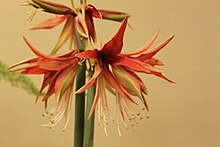Omphalissa
| Omphalissa | |
|---|---|

| |
| Hippeastrum cybister | |
| Scientific classification | |
| Kingdom: | Plantae |
| Clade: | Tracheophytes |
| Clade: | Angiosperms |
| Clade: | Monocots |
| Order: | Asparagales |
| Family: | Amaryllidaceae |
| Subfamily: | Amaryllidoideae |
| Genus: | Hippeastrum |
| Subgenus: | Omphalissa (Salisb.) Baker |
| Species | |
|
See article | |
Omphalissa is an unaccepted subgenus[1][2][3][4] of genus Hippeastrum, within the family Amaryllidaceae. Originally described by Richard Anthony Salisbury in 1866.[5]
Description[edit]
Robust habit, two to four large flowers. Perianth with a short tube(< 4 cm), paraperigonium curved closing the throat by a distinct neck. Stigma trifid or capitate, lobes > 2 mm. Spathe slit to the base. Ribbon-like leaves, 2.5 to 5 cm broad. Many dry, flat seeds.[1][6][7]
Taxonomy[edit]
Salisbury originally described the Omphalissa as a subgroup of the Zephyrantheae, then a tribe within the Amaryllidaceae, in which he included Amaryllis (now Hippeastrum) aulica and A. calyptrata. This was subsequently more formally defined by John Gilbert Baker in 1888, as a subgenus of Hippeastrum with six species.[6] Baker's six species were;
- Hippeastrum aulicum
- Hippeastrum organense (now Hippeastrum correiense)
- Hippeastrum psittacinum
- Hippeastrum calyptratum
- Hippeastrum cybister
- Hippeastrum pardinum
Ecology[edit]
Contains the epiphytic species of Hippeastrum.[8]
References[edit]
- ^ a b "Hippeastrum". Amaryllidaceae.org. Archived from the original on 2017-08-26. Retrieved 2013-11-30.
- ^ Traub, H.P. (1958). The Amaryllis Manual. New York: Macmillan. Retrieved 2013-11-30.
- ^ Traub, H.P. (1980). "The Subgenera of the Genus Amaryllis". Plant Life. 36: 43–45.
- ^ Vargas, C.J.C. (1984). "The Peruvian Species of the Genus Amaryllis (Amaryllidaceae)". Herbertia. 40: 112–134.
- ^ J. E. Gray. (ed.) Richard Anthony Salisbury. The Genera of Plants (Gen. Pl.): 134 (1866) (Unpublished fragment)
- ^ a b Baker, John Gilbert (1888). "Hippeastrum". Handbook of the Amaryllideæ including the Alstrœmerieæ and Agaveæ. Vol. 1888. London: Bell. p. 41. Retrieved 31 March 2014.
- ^ Baker, J.G. An enumeration and classification of the species of Hippeastrum, in Henry Trimen (ed.). Journal of Botany: British and Foreign, Volume 16. West, Newman & Company, London 1878, p. 81
- ^ "Amaryllidaceae épiphytes". Amaryllidaceae.org. Archived from the original on 19 December 2015. Retrieved 2 April 2014.
